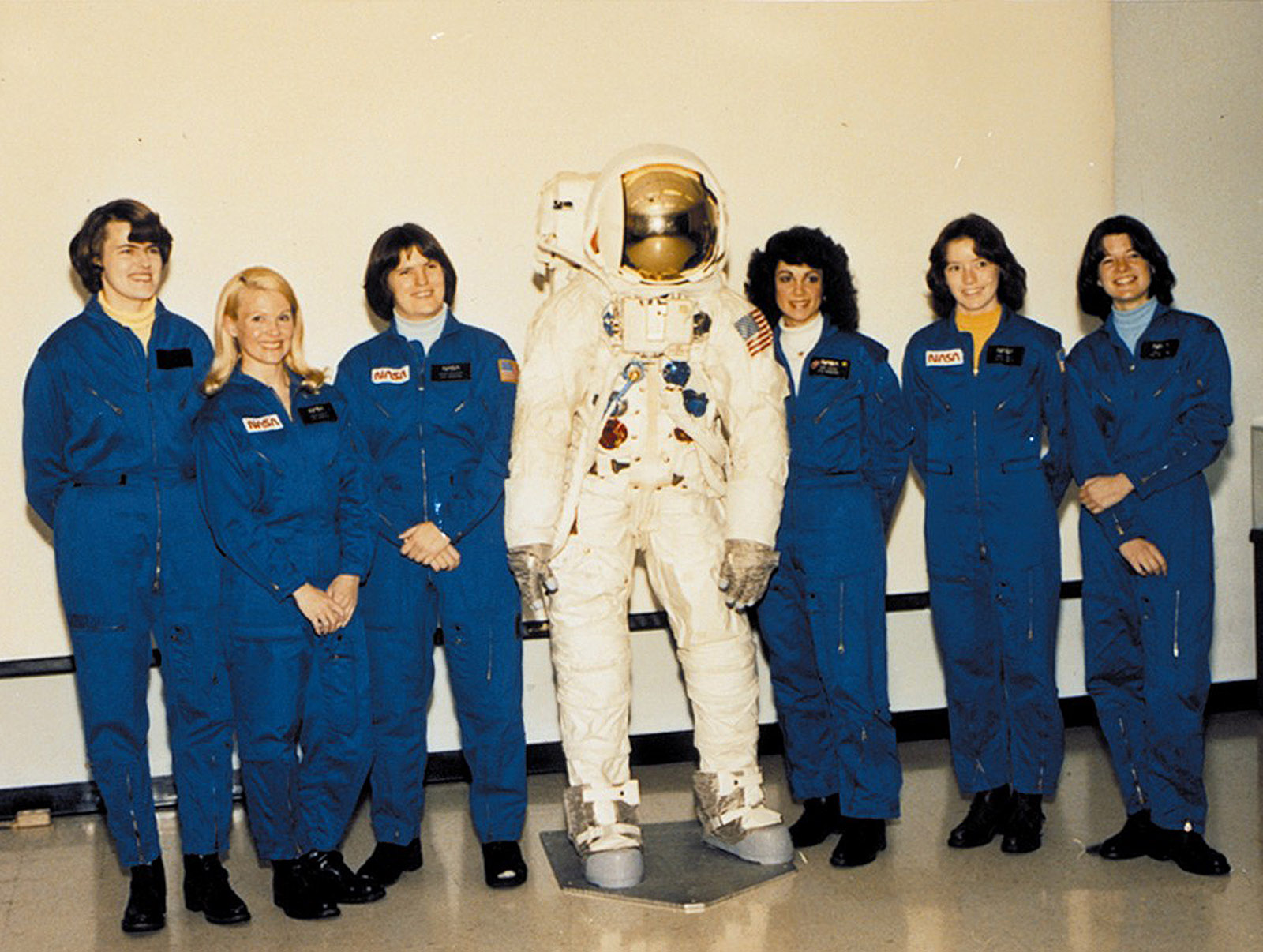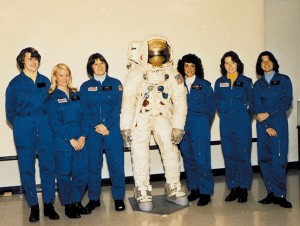
L to R: NASA’s first six women astronauts were Shannon W. Lucid, Margaret “Rhea” Seddon, Kathryn D. Sullivan, Judith A. Resnik, Anna L. Fisher and Sally K. Ride. All six women completed their training program in August 1979.
By Henry M. Holden
In January 1978, the National Aeronautics and Space Administration selected six women in an American team of 15 pilots and 20 mission specialists for the upcoming shuttle and space station programs. The women were Dr. Sally Ride, Dr. Margaret R. “Rhea” Seddon, Dr. Kathryn D. Sullivan, Dr. Judith A. Resnik, Dr. Anna L. Fisher and Dr. Shannon W. Lucid.
Five years later, in June 1983, Ride flew as a mission specialist on the seventh shuttle mission aboard Challenger STS-7, becoming the first American woman in space. She succeeded in a quest that many believed started 22 years, 36 manned missions and 57 astronauts after the first Mercury capsule splashed down in the Atlantic.
Some people said Ride changed the world above for millions of Americans, especially women. Space was no longer a man’s world, but Ride didn’t see it that way.
“From the Astronaut Office’s point of view, it was not a man’s world when I joined NASA along with five other women in 1978,” said Ride. “The attitude of both men and women in the program wasn’t whether you were a man or a woman, but whether you could do the job. The emphasis is on things that work—achievement.”
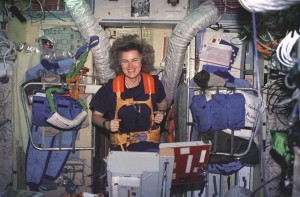
Astronaut Shannon Lucid exercises on a treadmill while on the Russian Mir space station’s Base Block module. Lucid still works at NASA.
In February 1960, long before Ride went into space, Look magazine quoted Air Force Brig. Gen. Donald Flickinger saying women wouldn’t be given serious consideration for space travel until “three person space vehicles were in use.”
Flickinger was being disingenuous. He and Dr. W. Randolph Lovelace II, the scientist responsible for medical screening of the Mercury astronauts, had already decided to screen a woman to see if she was fit for space travel.
Under a cover of secrecy
When NASA selected the first seven male astronauts in 1959, they also quietly selected 29 year-old Geraldyn “Jerrie” Cobb, the chief pilot for an Oklahoma aircraft company. Cobb, a fixed wing and helicopter pilot, had 7,000 flight hours, which was more than many of the male astronauts.
In August 1960, Lovelace broke the secret at the International Space Symposium in Stockholm, Sweden. TIME magazine quickly followed up with a story on Cobb’s progress. According to the article, she qualified to “live, observe and do optimal work in the environment of space and return safely to Earth.”
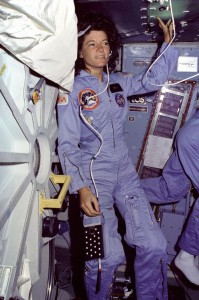
On Challenger’s middeck, mission specialist Sally Ride, wearing a communications headset, floats alongside the middeck airlock hatch. Ride became an astronaut by answering a help wanted ad placed by NASA on a Stanford University bulletin board.
Cobb had passed the first battery of tests, but she wasn’t yet ready for space travel. The most grueling tests lay before her: underwater isolation, a whirling centrifuge and the oven hot chamber. TIME magazine reported that if she passed all the tests she would “don a formless spacesuit, tuck her ponytail into a helmet and hop atop a rocket for the long, lonely journey into space.”
NASA, however, didn’t expect a woman to pass the tests and had no plans to deal with having a woman in the program. Cobb passed all the tests, and NASA had a problem. Flickinger thought he had the solution.
“The tests were preliminary; Cobb isn’t an official astronaut,” Flickinger said. “Women won’t go into space because NASA doesn’t have spacesuits to accommodate their particular biological needs and functions.”
Cobb had qualified for space travel, but NASA planned to eliminate the issue by allowing her and 25 other women pilots to continue to the next stage of astronaut testing, held at the Navy’s School of Aviation in Pensacola, Fla. Lovelace put all the female applicants through the testing program with no expectation that they would pass the tests. The women disappointed NASA officials again: 12 passed all the tests. Now NASA had 13 women—later called the “Mercury 13″—fully qualified for space travel, and no plans for incorporating them into the program.
Senate investigation
In July 1961, NASA canceled all training of the women. The agency hoped that would put an end to the issue, but one of the women, Janey Briggs Hart, was the wife of then- Sen. Philip A. Hart of Michigan. Within a year, Hart had a congressional subcommittee investigating the NASA policy.
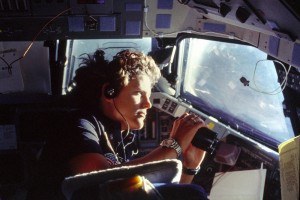
Astronaut Kathryn D. Sullivan, on board Challenger STS-41-G, uses binoculars for a magnified view of Earth through Challenger’s forward cabin windows.
Yuri Gagarin had already become the first human to orbit the earth. Astronaut John Glenn, the first American to orbit the Earth, went before Hart’s subcommittee to explain why NASA wasn’t training women. His answer was simple.
“The fact that women are not in this field is a fact of our social order. … Astronauts have to be jet test pilots and engineers and the women aren’t,” he said.
Russian woman launches into space
In June 1963, after the hearings began, the Russians beat America to the punch when they launched 26-year old Valentine Tereshkova into space. It was political one upmanship. Tereshkova’s presence added little more than prestige to the flight during her 48 orbits in the Vostok IV. She was a textile worker, and her aviation background was that of an amateur sky diver. While she did go on to become a respected international spokesperson for Soviet women, it would be 20 years before the Russians sent another woman into space, and then it was to upstage Sally Ride’s launch.
In 1964, NASA announced a new policy to recruit an elite corps of scientist astronauts for the upcoming Apollo and Skylab missions, and they encouraged women to apply. Many qualified women applied, but not one was chosen for the next 14 years.
False start
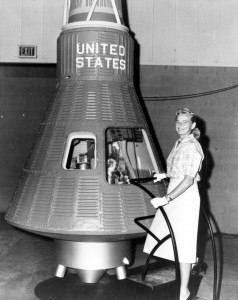
Jerrie Cobb, along with 12 other women, underwent physical tests similar to those taken by the Mercury astronauts. Cobb passed all the training, ranking in the top two percent of all astronaut candidates, male and female, but never flew in space.
In 1973, NASA began a new program for testing women to see if they could stand up to the physical and psychological stress of space flight, At first, U.S. Air Force flight nurses volunteered, but by 1977, test subjects included civilian women from all walks of life, ranging in age from 25 to 65. They were poked and probed, chilled, heated and confined, and the results confirmed what the scientists discovered in the early 1960s—women could endure the physical hardships as well as men, and often had better psychological profiles.
The female applicants did something the men didn’t do, surprising NASA. To endure the boredom and trauma of the tests, they formed a tightly knit support group. NASA realized the women had led them to an important discovery: zero gravity was an equalizer of men and women, and physical strength was no longer important. NASA had entered a new age where small groups of people depended on each other as a team.
Ride and the other five women completed their training in 1979, becoming active members of the space program.
“Women have never been excluded from the astronaut corps,” said Chris Kraft, NASA’s director of the Johnson Space Center, a year before Ride flew into space, and after she had served as capsule communicator for two space flights. “Whether they were black or yellow, male or female, it made no difference in the selective process. We’ve always set the requirements for the people we needed at a given time, and for a long time, women were not trained in those fields.”
Ride disagrees.

Astronaut Judith Resnik extinguishes a fire as part of her emergency training. Resnik, who perished aboard Challenger in 1986, held a doctorate in mathematics.
“They felt the push of the women’s movement,” she said. “It wasn’t a sudden, violent push, but a slow, relentless push, like the push of an Atlas rocket. It took time to ignite the engine and overcome the inertia of an attitude as ingrained as freedom itself. Once it began to push, it would not stop. Its direction was up, toward the stars and victory.”
Two years after her first space flight, Ride made another flight aboard the shuttle Challenger, STS-41-G, in October 1984. Another woman on the crew was Dr. Kathryn Sullivan, a geologist; it was Sullivan’s first space flight.
On the eve of her second shuttle mission, a reporter wondered if it meant anything that another woman would be on the flight.
“It doesn’t matter to the flight,” said Ride. “We’re both professionals, and as a crew we work well together. It’s also another stride forward for the space program. It proves that a women flying into space isn’t tokenism, because women are part of the crew.”
But it would take another 16 years before Eileen Collins became the first woman to command a space shuttle mission.
Where are they now?
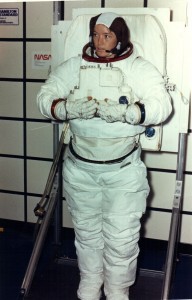
Astronaut Anna Fisher dons a hard-torso space shuttle extravehicle mobility unit. Dr. Fisher graduated from UCLA medical school in 1976.
Dr. Sally Ride completed two space flights, accumulating 344 hours in space. The 1986 explosion of Challenger during liftoff canceled Ride’s scheduled third mission. She became a member of the presidential commission that investigated the Challenger accident, and then went on to become an assistant to the administrator for long-range planning at NASA.
In the fall of 1987, Ride left NASA to become a science fellow at Stanford University’s Center for International Security and Arms Control. In 2001, she founded Sally Ride Science, an organization aspiring to support the large numbers of girls in elementary and middle school who are, or might become, interested in science, math and technology. She is also the author of three children’s books.
Among her numerous honors and awards, Ride is an inductee of the National Women’s Hall of Fame and the Astronaut Hall of Fame and has received the Jefferson Award for Public Service, the von Braun Award, the Lindbergh Eagle and the NCAA’s Theodore Roosevelt Award. Ride received the NASA Space Flight Medal twice.
Dr. Judith Resnik attended Carnegie Melon University, earning a BS in electrical engineering in 1970, and a doctorate in electrical engineering from the University of Maryland in 1977. She was employed by RCA as a design engineer and later joined the National Institutes of Health as a biomedical engineer, before becoming an astronaut.
Resnik first flew as a mission specialist on Discovery STS-41-D in August 1984, accumulating 144 hours, 57 minutes in space. Resnick and schoolteacher Christa McAuliffe perished in the Challenger launch accident. The Resnik crater, named in her honor, is located within the Apollo impact basin on the far side of the Moon.
Dr. Rhea Seddon served as a mission specialist in three missions: aboard the shuttle Discovery STS-51-D, which launched in April 1985; on Columbia STS-40 in June 1991; and on Columbia STS-58 in October 1993. She accumulated more than 722 hours in space. Seddon retired from NASA in November 1997, and became the assistant chief medical officer of the Vanderbilt Medical Group, in Nashville, Tenn. In 2005, she became an inductee into the Tennessee Aviation Hall of Fame.
Dr. Kathryn Sullivan’s first space flight was aboard Challenger STS-41-G in October 1984. During the mission, she and Commander Dave Leestma successfully conducted a three-and-a-half hour extravehicular activity, making her the first American woman to perform an EVA. Sullivan served on the crew of Discovery STS-31 in April 1990, and served as payload commander on Atlantis STS-45 in March 1992. With the completion of her third mission, she had logged more than 532 hours in space.
Sullivan left NASA in 1993, after accepting a presidential appointment to the post of chief scientist at the National Oceanic and Atmospheric Administration, where she oversaw research and technology programs ranging from climate and global change to satellites and marine biodiversity. She later served as president and CEO of the Center of Science & Industry in Columbus, Ohio. In 2007, she became the first director of the new Battelle Center for Mathematics and Science Education Policy at Ohio State University’s John Glenn School of Public Affairs. She continues to serve COSI as a science advisor in a volunteer capacity. She’s received numerous awards, including NASA medals for exceptional service and outstanding leadership and the National Air and the Space Trophy from the Smithsonian Institution’s National Air and Space Museum. The Astronaut Hall of Fame inducted Sullivan in 2004.
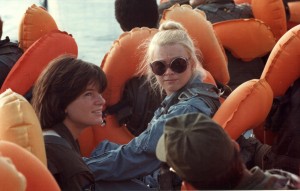
Rhea Seddon (center) and Sally Ride prepare to take part in water survival training, essential if the shuttle makes an emergency landing in the ocean or a lake.
Dr. Anna Fisher served as a mission specialist on Discovery STS-51-A in November 1984. Following the Challenger accident, she worked as the deputy of the Astronaut Office Mission Development Branch. After an extended leave of absence (1989-1996) to raise her children, Fisher returned to NASA, serving in various management positions. Fisher currently works on technical assignments in the Shuttle Branch. Among her awards are the NASA Space Flight Medal, Mother of the Year Award in 1984, Calif. Science Center Woman of the year in 1986, and the NASA Exceptional Service Medal, 1999. She’s logged a total of 192 hours in space.
Dr. Shannon Lucid’s space flights include Discovery STS-51-G in June 1985, Atlantis STS-34 in October 1989, Atlantis STS-43 in August 1991 and Columbia STS-58 in October 1993. Upon completion of that flight, Lucid had logged 838 hours—54 minutes in space. She became America’s female astronaut with the most hours in space and held the world record for most flight hours in orbit by a woman. Lucid currently holds the United States’ single-mission space flight endurance record, obtained while on the Russian space station Mir. This mission, her fifth, ended with her return to Kennedy Space Center aboard Atlantis STS-79 in September 1996. During that mission, Lucid traveled 75.2 million miles in 188 days, 4 hours.
On June 16, 2007, Sunita Williams, aboard the International Space Station, exceeded Lucid’s record for longest duration spaceflight by a woman. Lucid received the Congressional Space Medal of Honor in December 1996, becoming the tenth astronaut and first woman to be given that honor. Lucid is currently working at the Johnson Space Center in Houston. Her most recent assignments were capcom for Endeavour STS-118 and Discovery STS-120 in 2007.











